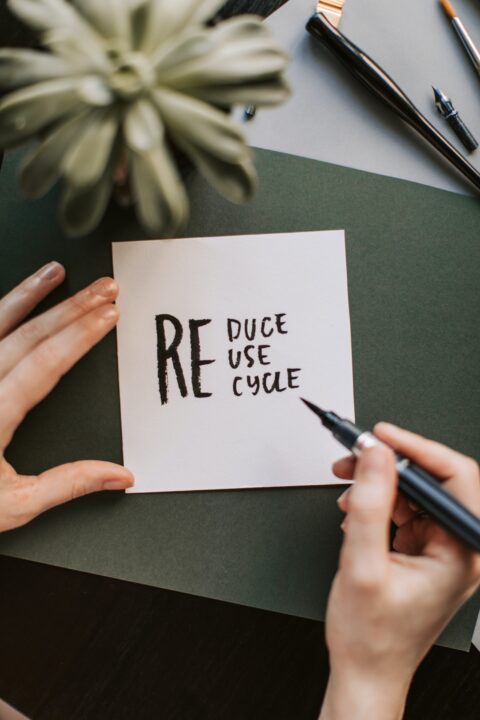Are you interested in helping society reduce environmental hazards and live a more sustainable lifestyle? If so, zero waste living tips may be the answer for you. Zero-waste living is a lifestyle that aims to eliminate any form of waste by refusing, reducing, reusing, recycling, and composting.
Many people are overwhelmed when they first learn about zero waste living tips. But the truth is, there are many simple things you can do to reduce your waste and make a difference for the planet. If you decide to take the step towards zero waste living, there are numerous resources available to help you get started.
Additionally, many communities of zero-waste enthusiasts can also provide you with support and inspiration. In this article, we will discuss zero waste living tips that you can start implementing today. These tips are simple and easy to follow, and they can make a significant difference in the health of our planet.
What Is A Zero-waste Lifestyle?
Zero-waste living is based on the belief that we as humans can live more sustainably by reducing our consumption of resources and waste production.
The zero-waste movement is an eco-friendly lifestyle that is aimed at preventing as much waste as possible from going to landfills and incinerators.
Adopting a zero waste lifestyle can be hard or seem impossible because it means breaking old habits and learning new ways to live. While it is impossible to create zero waste, there are many ways to reduce consumption that can benefit the planet.
The 5 Principles of Zero Waste Living
Refuse: Avoid products that you don’t need or want. This includes items like single-use plastics, disposable products, and junk mail.
Reduce: Minimize the amount of stuff you buy. This means buying less, going for durable products, and repairing items rather than replacing them.
Reuse: Utilize items multiple times whenever possible. This encompasses reusable water bottles, bags, and containers.
Recycle: Try to always recycle materials that cannot be reused. This aids in keeping them out of landfills and incinerators.
Compost: Decompose organic materials, such as food scraps and yard waste. This reduces methane emissions and creates nutrient-rich soil.
How to Get Started with Zero Waste Living Tips
There are many ways to get started with zero-waste living. Here are a few simple tips:
1. Start With A Mindset Shift.
Firstly, you have to make up your mind and instead of thinking of waste as something that needs to be disposed of, think of it as a resource that can be reused, recycled, or composted.
This mindset shift can help you make more sustainable choices in your daily life. For example, instead of throwing away a broken appliance, you could try to repair it.
2. Educate yourself about zero-waste living.
Read books and articles about zero-waste living
There are many great resources available to help you learn about zero-waste living. Follow zero-waste bloggers and influencers, take a zero-waste workshop or class, and also join a zero-waste community. Once you have educated yourself about zero-waste living, you can start to implement some of the tips in your own life.
Say no to straws and plastic utensils
Straws: Straws are one of the most common single-use plastics. They are used for a few minutes and then thrown away.
Plastic utensils: Plastic utensils are also a common single-use plastic and just like straws, they are often utilized for a moment and then disposed of. This contributes to a lot of waste. As an alternative to straws and plastic utensils, you can do the following:
- Bring your reusable straws and utensils when you go out to eat.
- Ask restaurants and cafes to serve your drinks without straws.
- Use bamboo or metal straws at home.
- Avoid disposable plastic utensils altogether.
3. DIY and upcycling
DIY: Do-it-yourself (DIY) projects can be a great way to reduce waste. When you DIY, you are reusing materials that would otherwise be thrown away.
Upcycling: Upcycling is a sustainable way to create new products by using materials that would otherwise be thrown away.
Upcycling can be a great way to give new life to old items and reduce waste. You can also get involved in DIY and upcycling in the following ways:
- Learn how to repair and mend clothes, furniture, and other items.
- Make your own cleaning products, cosmetics, and other household items.
- Upcycle old materials into new creations.
- Support businesses that offer DIY and upcycling workshops.
4. Eco-friendly Cleaning
There are many eco-friendly cleaning products available. These products are made with natural ingredients and are less harmful to the environment than conventional cleaning products. You can achieve eco-friendly cleaning in the following ways:
- Use natural cleaning products that are free of harmful chemicals.
- Make your cleaning products at home.
- Reuse rags and sponges instead of disposable paper towels.
- Compost your food scraps and yard waste to reduce the need for chemical fertilizers.
5. Spread Awareness
Talk to your friends and family about zero-waste living
Share your knowledge about zero-waste living with the people you know. This can help inspire them to make changes in their own lives.
Get involved with different organization
Many organizations are working to promote zero-waste living. Get involved in these organizations and help spread the word.
Use social media
Social media can be a great way to spread awareness about zero-waste living. Share information about zero-waste living on your social media accounts and encourage your friends and followers to make changes in their own lives.
6. Embrace second-hand shipping.
Second-hand shipping is the practice of shipping goods in reused packaging. This can help reduce the amount of waste generated by shipping. Embracing second-hand shipping may include
- Buying second-hand clothes, furniture, and other items whenever possible.
- Shopping at thrift stores and consignment shops.
- Supporting businesses that offer second-hand shipping options.
- Donate your unwanted items to charity or sell them at a garage sale.
7. Repair Instead Of Replacing
If something breaks, don’t throw it away. Try to fix it first. This will help to extend the life of the product and reduce the amount of waste that is created.
8. Donate Or Sell Unwanted Items
If you have items that you no longer need, donate them or sell them instead of throwing them away. Landfills release methane, a greenhouse gas that is 25 times more potent than carbon dioxide, into the atmosphere.
Methane is the third-largest source of human-related methane emissions in the United States. We can help reduce the amount of methane emissions that are released into the atmosphere.
9. Refuse What You Do Not Need
-

ekaterina belinskaya,pexels,4700114.jpg
Another step to zero-waste living is to refuse what you do not need. This means saying no to single-use items such as plastic bags, straws, and coffee cups. It also means being mindful of the products you buy and choosing ones that are packaged with sustainable materials.
10. Reduce Your Consumption
Another important tip for zero-waste living is to reduce your consumption. This means buying less stuff and making sure that the things you do buy are things that you need and will use.
11. Reuse Whenever Possible
When you do need to buy something, try to choose reusable items that you can use over and over again. This could include things like reusable water bottles, coffee mugs, and food containers.
12. Recycle and compost
Not everything can be reused, but most things can be recycled or composted. Recycling helps reduce the amount of waste that goes to landfills, and composting helps reduce the amount of food waste that ends up in landfills.
13. Bring Your Bags

When you go shopping, bring your bags instead of using the disposable bags that are provided. This will help reduce the amount of plastic waste that ends up in landfills.
14. Buy In Bulk
Bulk shopping is a sustainable way to reduce the amount of packaging you use. When you buy in bulk, you can bring your containers to the store, which will help reduce the amount of single-use packaging that you use.
15. Shop At Zero-waste Stores
There are a growing number of zero-waste stores that sell products that are packaged with sustainable materials. These stores can be a great resource for finding the products you need without creating waste.
Benefits of Zero-Waste Living
1. Reducing your carbon footprint
Your carbon footprint is the amount of greenhouse gas that you produce as a result of your everyday activities. When you reduce your carbon footprint, you are helping to mitigate climate change. Here are some ways to reduce your carbon footprint:
- Drive less. Instead of driving, walk, bike, or take public transportation whenever possible. This will help reduce the emissions from your car.
- Use energy-efficient appliances. When you buy new appliances, choose energy-efficient ones. This will help you save energy and reduce your carbon footprint.
- Insulate your home. This will help to keep your home warm in the winter and cool in the summer, which will reduce your energy consumption.
- Eat less meat. Meat production is a major contributor to greenhouse gas emissions. By eating less meat, you can help reduce your carbon footprint.
2. Conserving Resources
Resources are the materials and substances that we use to live our lives. When we conserve resources, we are using them more wisely and preventing them from being wasted. Below are some ways to conserve resources:
- Always Turn off lights and appliances when you leave a room.
- Ensure that you Unplug electronics when they are not in use.
- Fix leaky faucets.
- Buy products that are made from recycled materials.
- Buy products that are produced sustainably.
3. Protecting The Environment
The environment is the natural world around us. When we protect the environment, we are ensuring that it remains healthy and sustainable for future generations. Below listed are some ways to protect the environment:
- Reduce, reuse, and recycle.
- Conserve water and energy.
- Plant trees.
4. Feeling Good About Making a Positive Impact
When you make a positive impact on the environment, you are not only helping the planet, but you are also making yourself feel good. It is rewarding to know that you are making a difference, no matter how small. Here are some ways to feel good about making a positive impact:
- Volunteer your time for an environmental organization.
- Start a conversation about climate change with your friends and family.
- Make small changes in your own life, such as reducing your waste and driving less.
5. Reduces Environmental Impact
When you reduce your waste, you are helping to reduce the amount of pollution that goes into the environment. This can help to protect our air, water, and land.
6. Saves Money
Living a zero-waste lifestyle can save you money in the long run. This is because you will be buying fewer disposable products and more reusable items.
7. Improves Health
Living a zero-waste lifestyle can also improve your health. This is because you will be eating less processed food and more fresh, whole foods. You will also be reducing your exposure to toxins that can be found in disposable products.
Conclusion
Zero-waste living is a journey, not a destination. It can also be seen as a challenge, but it is also a rewarding one. By living a zero-waste lifestyle, you can make a difference for the planet and future generations.





